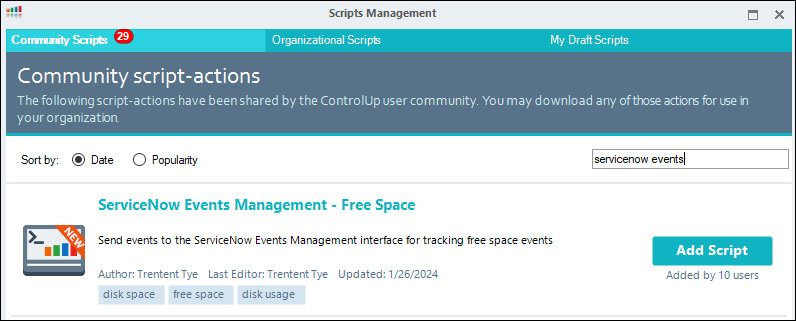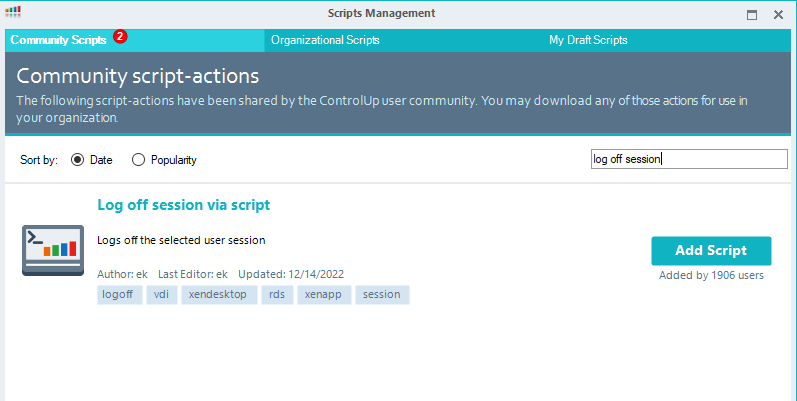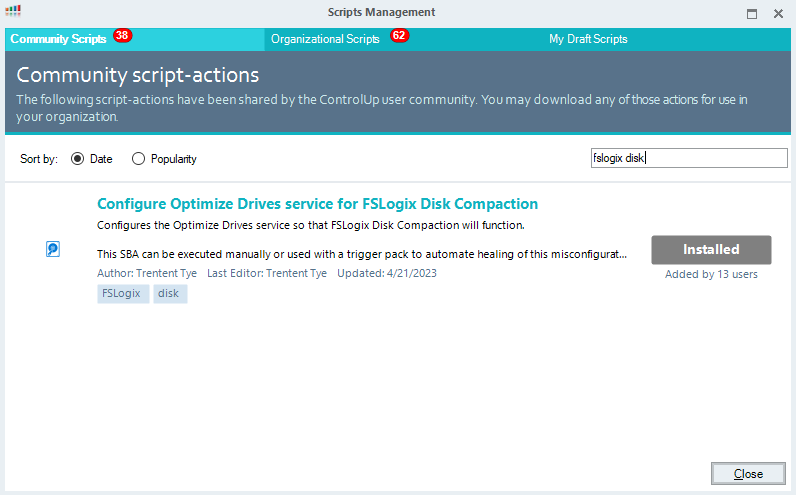Trigger packs are compiled by ControlUp for out-of-the-box monitoring of your environments. You can download these trigger packs and import them into your ControlUp organization. From version 9.0.5, you can configure triggers with PowerShell cmdlets.
Some triggers have corresponding script actions that automatically remediate the problem when the trigger activates. These triggers have "(with remediation script)" after their name. You can download the script from the community script library in the Real-Time Console.
Important
Some triggers require additional setup before you can use them. These triggers have "(additional setup required)" after their name. Read the contents of this article to learn what you need to set up.
Trigger activation conditions are preconfigured, but you can edit the trigger to set the following:
Scope - By default, entities in any folder of your ControlUp organization tree can activate a trigger. Change which folders can activate the trigger by setting the Scope.
Schedule - By default, a trigger can activate at any time. Set a schedule to limit when a trigger can activate.
Follow-up Action - Unless a trigger includes a remediation script action, the trigger records an incident when it activates but does not perform an action. You can configure the trigger to perform actions when it activates, such as sending an email alert or running a script.
For instructions on how to configure additional trigger settings, visit Setting up Triggers.
To import a trigger, go to Settings > Triggers > Import and select the downloaded trigger JSON file.
General
Machine - Free Space on System Drive < 5GB (with remediation script)
This trigger activates if the free space on a machine's system (C) drive is less than 5GB. You can add a follow-up action to the trigger to automatically clean the system drive and delete data from directories that are rarely used by running the script Clean Windows system drive.
You can download the script action Clean Windows system drive from the community script library in the Real-Time Console.
Create and resolve ServiceNow events based on free disk space (additional setup required)
Requires Real-Time DX version 9.0 or higher
This trigger is based on logical disk metrics that are available only in Real-Time DX version 9.0 or higher.
This trigger automatically creates a ServiceNow event if the free space on a logical disk is less than 5GB. By duplicating the trigger and reversing the trigger's activation conditions, you can also automatically resolve the ServiceNow event when the free space returns above 5GB. You must configure the script action ServiceNow Events Management - Free Space and add it as a follow-up action to the triggers to create and resolve the events. You can download the script action from the community script library in the Real-Time Console.
Datastore Read/Write Latency > 10ms
This trigger activates if read or write latency from a datastore is greater than 10ms.
Host Down
This trigger activates when a host is no longer connected.
Session Idle or Disconnected for 24 Hours (with remediation script)
This trigger activates when a session is idle or disconnected for 24 hours. You can add a follow-up action to the trigger to automatically log off the session by running the script Log off session via script. Note that you can change the scope of the trigger if you want to automatically log off sessions in only a certain folder in your organization tree.
You can download the script action Log off session via script from the community script library in the Real-Time Console.
Citrix
StoreFront Cannot Access Delivery Controllers (additional setup required)
This trigger activates if there is a connection problem between StoreFront and the Delivery Controller.
License Usage > 90%
This trigger activates if any of your Citrix licenses are above 90% utilization. The trigger uses the Top Citrix License Utilization column on your Citrix license server, which shows the Citrix license with the highest utilization percentage.
Broker Health < 100%
This trigger activates if a CVAD Broker has connection problems or its services are not running. The trigger uses the CVAD Broker Health column, which shows an overall health percentage determined from several broker services and database connections. If any of these are not working properly, then the broker health is less than 100%.
Server Load >= 10000
This trigger activates if a CVAD server load index is greater than or equal to 10000, indicating that the server is fully loaded. The trigger uses the column CVAD Server Load.
Unregistered Machine (with remediation script)
This trigger activates if a Citrix VDA is not registered to the connection broker. The trigger uses the CVAD Registration column, and will activate only if the VM is powered on and not in maintenance mode. You can add a follow-up action to the trigger to automatically restart the machine by running the script action Restart computer with CU Agent.
You can download the script action Restart computer with CU Agent from the community script library in the Real-Time Console.
NetScaler Cert Expiration < 15 Days
This trigger activates if your NetScaler license is 15 days away from expiration. The trigger uses the Days Until Next Certificate Expiration column.
NetScaler License Expiration < 15 Days
This trigger activates if your NetScaler license is 15 days away from expiration. The trigger uses the Days Until Next License Expiration column.
NetScaler Days With Unsaved Config > 14
This trigger activates if there is an unsaved change to the NetScaler applicance configuration for more than 14 days. The trigger uses the Days with Unsaved config column.
Free space on PVS Write Cache Drive < 10%
This trigger activates if the free space on your Citrix Provision (PVS) server is less than 10%.
Omnissa Horizon (formerly VMware Horizon)
Connection Server Services (additional setup required)
This trigger activates if any of the key Horizon connection server Windows services aren't running. The trigger monitors the following services:
Horizon Log Collector (integrated into VMware Support Assistant)
Blast Secure Gateway
Horizon Connection Server
Horizon Framework Component
Horizon Message Bus Component
PCoIP Secure Gateway
Horizon Security Gateway
Horizon Web Component
Horizon Secure Gateway (only when using cloud pod)
To use this trigger, you must add these services to your list of monitored services in the Real-Time DX Console (Settings > Service Monitoring). For more details, visit Using Windows Services to Activate Triggers.
Agent State (with remediation script)
This trigger activates if there is a problem with the Horizon Agent on a machine for more than one minute. The trigger might indicate that there is a connection problem, or the Horizon Agent is not running. You can add a follow-up action to the trigger to automatically restart the machine by running the script action Restart computer with CU Agent.
You can download the script action Restart computer with CU Agent from the community script library in the Console.
No Available Machines
This trigger activates if a Horizon Desktop Pool or RDS Farm has no available machines available.
Pool/Farm Availability
This trigger activates if a Horizon Desktop Pool or RDS Farm has less than 10% machines available.
Provisioning Disabled
This trigger activates if provisioning is disabled on a Horizon Desktop Pool or RDS Farm.
RDS Server Health
This trigger activates if an RDS server is in an unhealthy state. It does not activate if the server is disabled or in maintenance mode. The trigger uses the HZ RDS Server Health column.
RDS Farm Health
This trigger activates if an RDS Farm is in an unhealthy state. The trigger uses the HZ Farm Health column.
Pool/Farm Problematic Machines > 5
This trigger activates if a Horizon Desktop Pool or RDS Farm has more than 5 machines that have a problem. The trigger uses the HZ Problematic Machines column.
Connection Server Health
This trigger activates if a connection server is in an unhealthy state. The trigger uses the HZ Connection Server Health Status column.
FSLogix
FSLogix - Ensure Optimize Drives service is enabled (with remediation script)
This trigger activates if FSLogix Disk Compaction can't operate because the Optimize Drives service has been set to disabled. When activated, the trigger runs a script action that enables the Optimize Drives service to ensure that FSLogix Disk Compaction can execute.
You can download the script action Configure Optimize Drives service for FSLogix Disk Compaction from the community script library in the Real-Time Console.
FSLogix disk - empty blocks greater than 20%
This trigger activates if the percentage of empty blocks on a disk is greater than 20%. Empty blocks are blocks in a disk that no longer contain data, but consume space.
The trigger uses the FSLogix Disk % Empty Blocks column. You can view the column under Storage > FSLogix Disks.
FSLogix disk - free space less than 10%
This trigger activates if the percentage of free space on a disk volume is less than 10%.
The trigger uses the % Free Space column. You can view the column under Storage > FSLogix Disks.
FSLogix - healthy profile containers less than 100%.
This trigger activates if the percentage of FSLogix profile containers in a healthy state is less than 100%.
The trigger uses the FSLogix % Healthy Office Containers column. You can view the column by selecting the FSLogix column preset under the Machines view.
FSLogix disk - not healthy
This trigger activates if a FSLogix disk is not in a healthy state.
The trigger uses the Health column. You can view the column under Storage > FSLogix Disks. For more information about this column, click here.
FSLogix - not healthy
This trigger activates if FSLogix is not healthy.
The trigger uses the FSLogix Health column. You can view the column by selecting the FSLogix column preset under the Machines view.
FSLogix - profile in use (with remediation script)
This trigger activates if FSLogix generates an event that the user container is locked to another machine and starts the log off of the user from that machine holding the lock. The trigger uses the Event Log monitoring within ControlUp.
You can download the script action FSLogix - Logoff sessions with loaded profiles from the community script library in the Real-Time Console.
.png)
There are two scripts included in the trigger pack:
ControlUpFSLogixEventGenerator.ps1 – This script creates an event that ControlUp will recognize for its automation system. This script must be accessible by every machine you want this automation to apply. It can be stored locally on each machine or via a file share where the machine accounts have permissions to access.
CreateEventLogTask.ps1 – A convenience script to create a Event Viewer Task in task scheduler that detects the events in the FSLogix Operational log and starts the ControlUpFSLogixEventGenerater.ps1 script.
Microsoft AVD
Microsoft AVD OS Disk Caching Check
This trigger activates if the column AZ OS Disk Caching is set to none. Learn more about Azure disk caching.